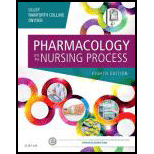
To answer:
The nurse is assessing a patient who is visiting the clinic for a 2-month follow-up appointment after starting selegiline (Eldepryl), 10 mg daily. The patient is pleased with the improvement in his Parkinson’s disease symptoms but states, “My wife looked up this drug and told me that I can’t eat cheese or drink wine anymore. I hate that, and I really don’t want to take this medicine.” What is the nurse’s priority action at this time?
Concept introduction:
Parkinson’s disease is a type of neurodegenerative disease associated with dementia, loss of ability to walk, numbness, and difficulty to think. It affects the older individuals. It mainly affects the motor system of the central nervous system. Gene therapy and Dopamine therapy are some of the ways to treat Parkinson’s at the early stage of detection.
Want to see the full answer?
Check out a sample textbook solution
Chapter 15 Solutions
Pharmacology and the Nursing Process, 8e
- true or false dark skinned infants should be screened for vitamin D levelsarrow_forwardtrue or false any practice employee is authorized to and should communicate collection guidelines with practice?arrow_forwardrtrue or false equesting a listing of specific creditreferences during patient intake os an acceptable business practice?arrow_forward
- give an overview on the respiratory assessmentarrow_forwardexplain an abdominal exam?arrow_forwardDiscuss β -Lactam antibiotics under the following subheadings Classifications of penicillins Classification of Cephalosporins General Mechanism of Actions Clinical Indications of penicillins and cephalosporins Adverse effects of β-lactamsarrow_forward
- a. Define neoplasm b. Differentiate between benign and malignant tumours c. Describe the molecular basis of cancerarrow_forwarddifferentiate the extra heart sounds S3,S4, murmurs and gallopsarrow_forward• Define shock and list types of shock • Discuss pathogenesis of septic shock. • Enumerate the stages of shock. • Define oedema and describe the pathophysiologic mechanisms of oedema with examples.arrow_forward
- Discuss Hypertension under the following headings: Definition Diagnosis Non-pharmacological intervention Drugs Classification Management of a Hypertensive emergencyarrow_forwardExplain how the answer could be 2 or 1.8 WITHOUT changing the questionarrow_forwardoverview of the neurological system, cranial nerves and what part of the body it innervatesarrow_forward
 Phlebotomy EssentialsNursingISBN:9781451194524Author:Ruth McCall, Cathee M. Tankersley MT(ASCP)Publisher:JONES+BARTLETT PUBLISHERS, INC.
Phlebotomy EssentialsNursingISBN:9781451194524Author:Ruth McCall, Cathee M. Tankersley MT(ASCP)Publisher:JONES+BARTLETT PUBLISHERS, INC. Gould's Pathophysiology for the Health Profession...NursingISBN:9780323414425Author:Robert J Hubert BSPublisher:Saunders
Gould's Pathophysiology for the Health Profession...NursingISBN:9780323414425Author:Robert J Hubert BSPublisher:Saunders Fundamentals Of NursingNursingISBN:9781496362179Author:Taylor, Carol (carol R.), LYNN, Pamela (pamela Barbara), Bartlett, Jennifer L.Publisher:Wolters Kluwer,
Fundamentals Of NursingNursingISBN:9781496362179Author:Taylor, Carol (carol R.), LYNN, Pamela (pamela Barbara), Bartlett, Jennifer L.Publisher:Wolters Kluwer, Fundamentals of Nursing, 9eNursingISBN:9780323327404Author:Patricia A. Potter RN MSN PhD FAAN, Anne Griffin Perry RN EdD FAAN, Patricia Stockert RN BSN MS PhD, Amy Hall RN BSN MS PhD CNEPublisher:Elsevier Science
Fundamentals of Nursing, 9eNursingISBN:9780323327404Author:Patricia A. Potter RN MSN PhD FAAN, Anne Griffin Perry RN EdD FAAN, Patricia Stockert RN BSN MS PhD, Amy Hall RN BSN MS PhD CNEPublisher:Elsevier Science Study Guide for Gould's Pathophysiology for the H...NursingISBN:9780323414142Author:Hubert BS, Robert J; VanMeter PhD, Karin C.Publisher:Saunders
Study Guide for Gould's Pathophysiology for the H...NursingISBN:9780323414142Author:Hubert BS, Robert J; VanMeter PhD, Karin C.Publisher:Saunders Issues and Ethics in the Helping Professions (Min...NursingISBN:9781337406291Author:Gerald Corey, Marianne Schneider Corey, Cindy CoreyPublisher:Cengage Learning
Issues and Ethics in the Helping Professions (Min...NursingISBN:9781337406291Author:Gerald Corey, Marianne Schneider Corey, Cindy CoreyPublisher:Cengage Learning





